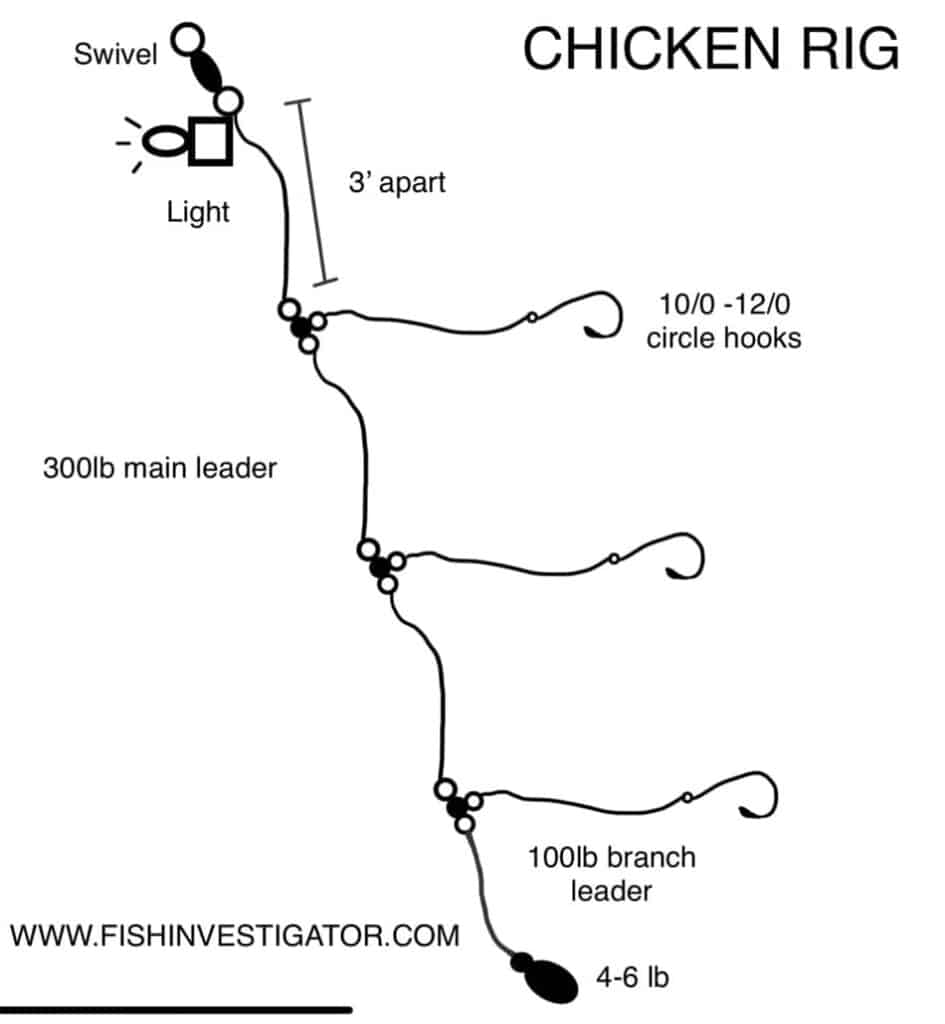
Fishing for Tilefish is a thrilling deep-drop fishing adventure. When you hook up to one of these bottom-dwelling creatures, you will quickly realize why so many anglers travel 100’s of miles to target these fish.
How Do You Catch Tilefish?
Tilefish are caught deep-dropping muddy ocean bottoms in depths ranging from 500 to 900 feet. Anglers target these fish using a chicken rig (a fishing rig outfitted with 3 to 4 hooks), a submersible light, and a sinker. Tilefish eat many bottom-dwelling creatures but are often caught using Squid.
Tilefish are bottom-dwelling fish caught in the ocean’s deep depths using heavy fishing tackle, including large electric reels, heavy power rods with fast action tips, and 80lb plus braided line. When targeting these benthic (bottom-dwelling) fish, locating muddy, sandy, or clay bottoms is crucial. These soft bottoms are the preferred habitat for Tilefish since they are often found burrowing in the ground for protection from other predators and camouflaging themselves as they passively hunt for food. Once you are out at the fishing grounds and marking soft bottom, it is time to drop down your fishing rigs. This rig can either be a “chicken rig” or a “lay down rig.” The only difference between the two is that the “laydown rig” has two sinkers, whereas the “chicken rig” only has one. We have the same luck fishing both rigs, but many captains swear by the “lay down rig” since it keeps all the individual baits on the ocean floor. There is no need to set the hook when fishing for Tilefish since the sinker’s weight will set the hook against the moving fish. The moment you are hooked up, you will notice light to moderate tapping on the tip of your rod, at which point it’s time to begin the retrieval.
Expert Tips On How to Catch Tilefish
- No light, no bite: Using a submersible light is essential when targeting Tilefish. Only a small portion of light travels down to the depths that Tilefish inhabit. This makes it crucial that your rig is outfitted with a light to attract the fish to your baits.
- Fresh bait is key: Squid, Bonita, Barracuda, and other forms of fresh-cut bait work best.
- Keep the boat stationary: Tilefish are lazy fish, often leaving their burrows to travel only a couple of feet for food, and since they are hesitant to chase their food, keeping the boat as still as possible is essential. The best way to do this is to set a mark on your GPS and aim your boat into the current, keeping the exact latitude and longitude. It may sound crazy that the drift of your vessel could limit your ability to catch fish, but once you realize that many oceanic currents travel around 6 mph, you can understand why this could affect your fishing success.
- Bounce your sinker: Bouncing your sinker off the bottom is a great way to create commotion and attract fish to your rig.
- Check the marine forecast: Tilefish fishing is the most productive on sunny calm days.
- Get stuck in the mud: When you drop down to the bottom, you will know you are fishing Tilefish territory if your sinker gets stuck in the ground. If the bottom feels rocky, retrieve your rig and move to another location. Not only will you have better luck fishing, but you won’t be losing expensive fishing rigs on the rocky bottom.
Let’s take a deeper look at how to catch Tilefish by learning more about the species as a whole.
What Are Tilefish?
Tilefish are bottom-dwelling fish found in the tropical and subtropical waters of the Atlantic, Pacific, and Indian oceans. Tilefish are in the Malacanthidia family, comprising over 40 different species. Tilefish are commonly referred to by a couple of names, including blanquillo and “clownfish of the sea.” The Golden tilefish is one of the largest species of Tilefish, often targeted by anglers growing to a length of over 45 inches. The Golden Tilefish is often characterized by their blueish-grey back, goldish-yellow spots, russet head, and blue eyes. Being a bottom-dwelling creature, Tilefish have large eyes to bring in as much light as possible, allowing them to hunt in minimal light conditions.
When Can You Catch Tilefish?
Tilefish can be caught year-round in tropical and subtropical climates, often being most active during the spawning season. Spawning season in the Atlantic starts in March and ends in October. Spawning season in the Gulf of Mexico begins in January and ends in June. Tilefish are most active feeding during daylight hours, particularly on sunny days where enough light can travel into deep waters to help them find food. Still, the amount of light that travels through the water column is minimal, so using submersible lights is still crucial for success.
Where Can You Catch Tilefish?
Tilefish, being bottom dwellers, are typically found in waters from 500 feet to 900 feet but have been found in waters as deep as 1,500’. Tilefish prefer sandy/muddy buttons, creating burrows on the ocean floor for hunting and shelter. Golden Tilefish are often targeted in waters north of Massachautes down to the Gulf of Mexico and have been found to be most populous in water temperatures in the upper 50’ Fahrenheit. Luckily at the depths Tilefish inhabit, this is year-round, so there is no need to wait for winter.
What Are The Best Baits For Tilefish?
- Bonito Strips
- Baracadua Strips
- Whole Squid
What Is the Natural Diet Of A Tilefish?
- Crabs
- Shrimp
- Mollusk
- Worms
- Urchins
Are Tilefish Good Eating?
Tilefish are phenomenal eating, often being compared to the taste of a lobster or crab. The flesh is firm and flaky with a mild sweet flavor. Though Tilefish are delicious, I would not recommend consuming this fish regularly due to their high mercury content.
Are Tilefish High In Mercury?
According to the FDA, Tilefish are extremely high in mercury, coming in at 1.123 PPM. To put that in perspective, 1 ounce of Tilefish has 29 times the mercury content as salmon. Though Tilefish caught in the Atlantic Ocean have significantly lower mercury levels than ones caught in the Gulf of Mexico, it is still recommended to avoid consumption in both locations.
Are Tilefish Related To Grouper?
Tilefish are not related to grouper. Tilefish are in the Malacanthidai Family, and grouper is in the Serranidae family.
Are Tilefish Poisonous?
Tilefish are not poisonous, but high levels of mercury found in these fish can be harmful to humans.
Do Tilefish Have Teeth?
Tilefish have small sharp teeth on both their top and bottom jaw.
Do Tilefish Have A Size Limit?
Tilefish do not have a size limit but have bag limits that vary depending on where they are being targeted.
Gulf bag limit: 100 pounds or 2 per person, whichever is greater.
Atlantic bag limit: 1 per person
Do Tilefish Have Any Natural Predators?
Tilefish are often preyed on by other fish, including monkfish, dogfish, sharks, eels, and even larger Tilefish.
Tilefish Fun Facts
- Tilefish are known to live over 40 years
- The Chameleon Tilefish can change colors to escape predators
- Tilefish are often called “clownfish of the sea.”
- In the late 1800s, millions of Tilefish died due to cold subarctic waters moving into their habitat. Many marine scientists believed this was the end of the Tilefish species until population numbers started to increase.
- The Purple Tilefish is a coveted aquarium fish worldwide, often demanding high prices in local aquarium shops.
Fishing Tackle For Tilefish
Fishing Rod
There are several quality rod setups when fishing for Tilefish. We recommend that deep-dropping rods have a curved butt for optimal fishing comfort. The curved butt allows you to swing your fishing rig into the boat for maintenance and re-rigging. Here are a few of the rods we recommend for Tilefish:
- Fiblink Bent Butt Fishing Rod 2-Piece Saltwater Offshore Trolling Rod Big Game Roller Rod Conventional Boat Fishing Pole
- Melton Tackle Deep Drop Rod
- Daiwa Saltiga G Dendoh Deep Drop Rods
Best Electric Fishing Reels For Tilefish
Tilefish are deep-dwelling fish, so it is essential to bring an electric reel. Here are three electric reels we recommend when targeting Tilefish:
Best: Shimano Tiagra 80 Hooker Electric Reel with Autostop
Better: Lindgren Pitman SV-1200 Electric Fishing Reel
Good: Banax Kaigen 1000 Electric Fishing Reel
Fishing Line
50-65lb braid is a great option when targeting Tilefish. It is essential when deep-dropping that you are using braid rather than monofilament. Braid has little to no stretch adding sensitivity to the rig. The added sensitivity is essential in being able to sense bites at depths over 500 feet.
Leader
We recommend using either a “lay down rig” or a “chicken rig” when fishing for Tilefish. No matter the rig you decide to use, we recommend using 80lb to 100lb fluorocarbon.


Best Hooks For Tilefish
10/0 to 12/0 circle hooks are best when targeting Tilefish.
Proper Sinker Size For Tilefish
We recommend 4 to 10 ounces of sinker per hundred feet when deep dropping depending on the current strength. Our typical sinker size is 4lb to 5lb pounds to hold the bottom.
